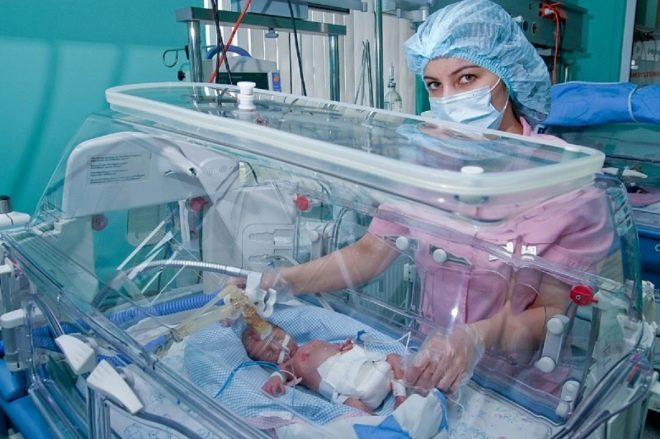At what week of pregnancy do you give birth most often and what does it depend on?
Every expectant mother wants to know when her birth will occur. And an exact answer to this question is possible only if a cesarean section is planned for medical reasons, and the date has already been set. In all other cases, this question remains open.
Average statistics
Childbirth begins when both the woman and the baby are ready for this. This preparation is very painstaking, it takes place at various levels - from hormonal to muscle. therefore unequivocal answer to the question when to give birth, no one can give, because the pace of preparation of female and child organisms for childbirth in different women is different.
There is medical statistics, which allows you to make only an approximate picture of what is happening and understand which week gives birth most often. If we consider that the pregnancy lasts 40 obstetric weeks (when counting from the first day of the last to conception of menstruation), then the full-term pregnancy is considered to be from 37 to 42 weeks. Exactly at the end of the 40th week is the same DA (the expected day of birth), on which many moms place such high hopes.
It’s not worth hoping for the DA, as it exists only as an approximate “signal flag” that allows women and doctors to better navigate in the gestational age.
On this day, which proudly flaunts the exchange card of every expectant mother since registration in consultation, childbirth occurs, according to WHO, only 5% of cases.
The first birth more often occurs on the period of 39-40 weeks and 40-41 week (these two weeks account for up to 75%) of cases of birth of the firstborn. Repeated labor most often occurs at 38-39 week and at 39-40 week (30 and 50% respectively). Up to 41-42 weeks, about 4% of women wear babies.
If we consider preterm laborthat occur from 22 weeks of gestation to 37 weeks then the most frequent delivery period is 32 to 34 weeks. Very rarely give birth at 24-26 weeks. The fetus from 22 weeks of gestation is considered viable, however, the survival rate at this time is very low, and the risk of disability of the survivors is vice versa.
As pregnancy increases, survival projections are increasingly favorable. Those born at 23 weeks survive in 16% of cases, and those born at week 29 in 90% of cases, the risk of irreversible effects from premature birth also decreases as the baby matures.
Planned cesarean section is done, according to the clinical recommendations of the Ministry of Health of Russia, for a period of 39 complete obstetric weeks. Emergency cesarean section for urgent indications can be carried out at any time when it is necessary.
What can affect?
The duration of carrying a baby depends on the health of the woman and the health of the baby, as well as on the characteristics of the current pregnancy. All factors are too numerous to list, and therefore we will touch only the most common ones.
- Genetic predisposition. To understand whether a woman is likely to give birth prematurely or to carry her child, you need to find out when the birth of her own mother and grandmother took place. If women in the family gave birth prematurely, there is every reason to believe that in this case nature will repeat the genetic program.
- Age factor. Too young pregnant women (up to 20 years old) and old moms who are over 36 years old, more often than others, deviate significantly from the day marked as da, in one direction or another.
- Birth order. Primiparous women longer prepare for childbirth - muscle tissue is less stretched, the cervix is tighter, and therefore they have a tendency to belated birth. The more births in the personal history, the higher the likelihood that the labor will take place ahead of the term of the DA.
- Health. Chronic illnesses of the future mother always increase the likelihood of premature delivery, and endocrine pathologies, on the contrary, more often lead to perenashivaniyu.
- Negative external conditions. Smoking, alcohol during pregnancy, as well as prolonged stress experienced by the expectant mother, increase the likelihood of childbirth ahead of schedule. Low physical activity, obesity promote perenashivaniyu.
- Emotional unavailability of women for childbirth. Fear of labor often leads to the fact that the cervix does not mature in time, labor does not begin for a long time. The desire to give birth quickly, if it is strong, may well lead to childbirth ahead of time.
- Multiple pregnancy. Twins and triplets exert a stronger pressure on the inner throat of the uterus - a kind of locking ring. The stronger this pressure, the faster the birth begins. Therefore, twins and triplets are usually born before 39 weeks.
- Individual biological rhythms. Women with a short menstrual cycle (less than 28 days) usually give birth before the DA for 1-2 weeks, and women with a long menstrual cycle carry children up to 41 weeks or even more.
The cause of delivery before term or prolongation of pregnancy in most cases cannot be reliably established. Therefore, the gestation period measured by nature for a particular woman is simply taken for granted.
Preterm birth
Speaking of preterm labor, one should not think that such situations can be considered when a child is born 2-3 weeks before the DA. We are talking about childbirth, in which the fetus is functionally and physically immature - from 22 to 37 week.
For physicians, still not everything is clear in the causes and mechanisms of development of such genera. Neither the child nor the mother is obviously ready for labor at 22 weeks and a little later, but something in the pregnant woman’s body triggers that very clan dominant, which starts the process of expelling fetus. The exact cause of childbirth that occurred before the due date is usually not established. Therefore, there are only factors that are considered predisposing:
- from the mother - surgical operations on the uterus, miscarriages and abortions in history, premature labor earlier;
- by the child - developmental anomalies, rhesus-conflict, pelvic presentation;
- features of pregnancy - Polyhydramnios and oligohydramnios, ICI, neoplasms in the uterus, cervix, genital infections, viral infections transferred in the early period.
But you should also consider the situation in which the expectant mother lives. If a woman is poorly nourished, often nervous, experiencing a lack of important vitamins, then the probability of giving birth ahead of time increases.
A fetus from 22 weeks is only conditionally viable, it all depends on how much its body is ready for extrauterine life. Viability increases with the term. It is noticed that boys are more often born prematurely than girls.
Delivery after the DA
The situation when the proposed day of childbirth has already passed, and the woman does not even observe the forerunners of emergency labor, is also quite widespread. The main thing is to maintain restraint and calm and not try to independently stimulate and provoke childbirth. Until 42 weeks, pregnancy is not postponed, but prolonged, and these are two different things.
Consider what the reasons may lead to the extension of gestation.
- Wrong time limit. Usually this happens infrequently.To be mistaken with the calculations, you need not to know or completely forget when exactly the last menstruation occurred, not to remember not only the day, but also the month. This happens after long-term hormonal treatment, prolonged use of oral contraceptives, failure of the ovaries. Then the term of pregnancy and the DA will be determined by the results of the ultrasound in the first trimester. Deviation in 2 weeks from the norms of fetometry is not considered a developmental delay, and a woman has 2 extra weeks in pregnancy.
- Large and giant children. A birth weight of 4 kilograms gives reason to call the fruit large, and a weight of 5 kilograms - gigantic. Such babies usually prefer to sit in my mother's womb to the last.
- Hormonal disorders. A small amount of oxytocin, estrogen and elevated levels of progesterone create not the most favorable background for the onset of labor. While progesterone remains high, the generic dominant at the hormonal level does not add up.
- Sedentary and inactive lifestyle. Muscles are weakened, their tone is reduced, this applies to all muscles, including the muscles of the uterus, cervix.
- Threats of miscarriage during pregnancy. Often, women say that they "so successfully preserved a pregnancy that they could not then persuade the baby to be born." The point is not that medications were used to preserve the pregnancy, but that the woman was psychologically tuned to continue the pregnancy, and now at the psychogenic level it is very difficult to persuade her to let go of the child, whom she managed to keep so hard.
How to solve the burden of time?
As you can see, the concept of “on time” is quite broad, and a woman cannot influence many factors. But what depends on it should be done in strict accordance with the recommendations of the doctor. This will help preserve the pregnancy and prevent preterm birth and not prolong the pregnancy.
This will help in simple tips:
- Do not hide your obstetric history from the doctor (even if you really want to hide the fact of abortion);
- do not miss regular scheduled visits to the antenatal clinic;
- lead a healthy and active lifestyle throughout the pregnancy;
- Do not neglect examinations and screenings in order to identify pathologies, complications and risk factors in time.
About how long the pregnancy lasts, a specialist in the video below.


















